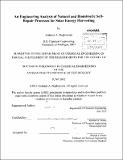| dc.contributor.advisor | Michael S. Strano. | en_US |
| dc.contributor.author | Boghossian, Ardemis A. (Ardemis Anoush) | en_US |
| dc.contributor.other | Massachusetts Institute of Technology. Dept. of Chemical Engineering. | en_US |
| dc.date.accessioned | 2013-01-23T19:41:57Z | |
| dc.date.available | 2013-01-23T19:41:57Z | |
| dc.date.copyright | 2012 | en_US |
| dc.date.issued | 2012 | en_US |
| dc.identifier.uri | http://hdl.handle.net/1721.1/76478 | |
| dc.description | Thesis (Ph. D.)--Massachusetts Institute of Technology, Dept. of Chemical Engineering, 2012. | en_US |
| dc.description | Cataloged from PDF version of thesis. | en_US |
| dc.description | Includes bibliographical references (p. 191-201). | en_US |
| dc.description.abstract | Plants have evolved highly sophisticated mechanisms of self-repair to regenerate proteins that become photo-damaged over time. Key to this self-repair process is the reversible self-assembly of protein complexes, which is characterized by the molecular recognition of parts, kinetic trapping of meta-stable thermodynamic states, and chemical signaling to switch between states. In this thesis, we mimic such regenerative mechanisms in an effort to develop biological light-harvesting devices with prolonged lifetimes. We demonstrate the first synthetic photoelectrochemical cell capable of mimicking key aspects of the self-repair process. Surfactant addition and removal was used to signal between the disassembly and re-assembly of a photoactive complex demonstrating photo-conversion efficiencies of 40%. These dynamic complexes consist of lipid bilayer disks housing photoactive reaction centers (RCs) that align along the length of a single-walled carbon nanotube (SWNT). Application of a regeneration cycle that reversibly signals between the assembled and disassembled states extends the lifetime of the photoelectrochemical cell indefinitely and increases cell efficiency by over 300% over 168 hours. We modeled the kinetic and thermodynamic forces that drive the reversible self-assembly, and we fit this model to spectrofluorimetric measurements that monitor complex formation. The bestfit rate constants for lipid bilayer and bilayer-nanotube complex formation are 79 mM-Is'Iand 5.4x 10 mM-1 s- 1, respectively. We find that these reactions do not occur under diffusioncontrolled conditions, and the phase diagram predicts a locally optimal surfactant removal rate of 8 x 10-4 s-1. This model was subsequently fit to cyclic complex assembly and disassembly measurements, demonstrating that the forces modeled in this study may form the basis for synthetic and natural photoactive complexes capable of dynamic component repair. In an effort to extend our scope to study natural regeneration mechanisms, we established a platform for quantifying reactive oxygen species (ROS) generation in isolated chloroplasts capable of autonomous regeneration. ROS generation from illuminated chloroplasts from S. oleracea was examined in the presence of dextran-wrapped nanoceria (dNC), cerium ions (Ce3 ), fullerenol, and DNA-wrapped SWNTs. ROS concentrations were evaluated using the oxidative dyes, 2',7'- dichlorodihydrofluorescein diacetate (H2DCF-DA) and 2,3-bis(2-methoxy-4-nitro-5- sulfophenyl)-2H-tetrazolium-5-carboxanilide sodium salt (XTT). Chloroplast photoactivity was monitored throughout the illumination period using chloroplast fluorescence and the artificial, photosynthetic electron accepting dye, dichloroindophenol (DCPIP). The results of this study indicate that dNC offers a promising mechanism for effective ROS scavenging whilst preserving chloroplast photoactivity at concentrations below 5 [tM. We have also established several platforms for studying the glucose production of isolated chloroplasts for biofuel cell applications. We developed an algorithm to quantify single-molecule efflux measurements from individual, photoactive chloroplasts. Near-infrared fluorescing SWNTs have been used in previous studies to report single-molecule binding events via stochastic fluctuations in fluorescence. In this thesis, we develop and compare several algorithms for extracting concentration-dependent rates from the stochastic fluctuations. Overall, the birthand- death model most accurately predicts the rate constants, whereas the moment analysis is more accurate at large forward rates (>10-3 s-1). Glucose efflux from chloroplasts was characterized using a glucose oxidase assay, high-pressure liquid chromatography (HPLC), and a biofuel cell. Calculated export rates of 1.9 and 6 tmol/(mg chlorophyll hr) were measured using the HPLC and fuel cell, respectively. Maximum power densities of 110 pW/cm 2 were achieved with alginate encapsulated chloroplasts. In the presence of regenerative materials, such as dNC, this biofuel cell setup provides a promising platform for demonstrating a biological lightharvesting construct capable of autonomous regeneration | en_US |
| dc.description.statementofresponsibility | by Ardemis A. Boghossian. | en_US |
| dc.format.extent | 386 p. | en_US |
| dc.language.iso | eng | en_US |
| dc.publisher | Massachusetts Institute of Technology | en_US |
| dc.rights | M.I.T. theses are protected by
copyright. They may be viewed from this source for any purpose, but
reproduction or distribution in any format is prohibited without written
permission. See provided URL for inquiries about permission. | en_US |
| dc.rights.uri | http://dspace.mit.edu/handle/1721.1/7582 | en_US |
| dc.subject | Chemical Engineering. | en_US |
| dc.title | An engineering analysis of natural and biomimetic self-repair processes for solar energy harvesting | en_US |
| dc.type | Thesis | en_US |
| dc.description.degree | Ph.D. | en_US |
| dc.contributor.department | Massachusetts Institute of Technology. Department of Chemical Engineering | |
| dc.identifier.oclc | 822232286 | en_US |
